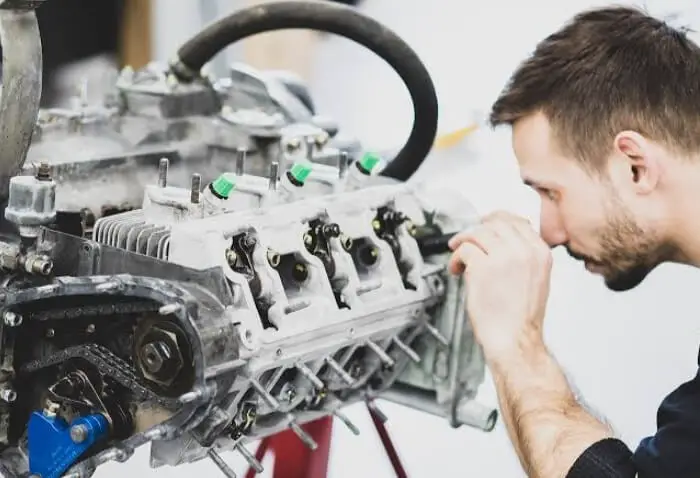As an Amazon Associate, we earn from qualifying purchases. This does not affect the price you pay or the quality of the products you buy. For more information, please read the full affiliate disclosure here.
As a generator mechanic with years of experience working on both diesel and gasoline generators, I have seen my fair share of overspeed issues.
Generator Overspeed is a common problem that can cause significant damage to the engine if left unresolved.
So you shouldn’t wait for it to damage your generator before you fix it.
Hence, in this blog post, I will explain why generators overspeed and provide the best ways to fix generator overspeed issues.
What is Generator Overspeed?
Before delving into the reasons and causes why generators overspeed, you must understand what it means.
Generator Overspeed is a result of when the engine is running at a speed higher than the recommended or rated speed.
That’s to say, generators are designed to operate within a specific speed range, and exceeding this range can cause significant problems, including engine damage.
Based on what I have seen from most of my clients’ generators, it ends up breaking their engine crankcase.
Also Read:-How to Reduce Voltage in Generator in 4 Simple Ways
Why Do Generators Overspeed?
There are several reasons why generators Overspeed. The reasons include:
1. Load Rejection
Certainly! Load rejection is a phenomenon that occurs when the electrical load on a generator is suddenly reduced or completely disconnected.
This sudden reduction in load causes the engine’s speed to increase since there is no longer any resistance holding it back.
If the governor fails to detect and adjust to the increased engine speed, the generator can enter overspeed, where the engine runs faster than the recommended or rated speed.
For example, imagine a large industrial facility that relies on a generator for backup power during a power outage.
If the power goes out suddenly, the generator will kick in and start providing electricity to the facility.
However, if the facility’s electrical load suddenly drops due to a malfunctioning machine or equipment being turned off, the generator will experience load rejection.
The sudden drop in load will cause the engine to speed up, potentially causing overspeed if the governor fails to adjust the engine speed.
Similarly, if a large load is disconnected from the generator without first reducing the load gradually, the generator will experience load rejection, potentially causing overspeed.
This is why it’s important to follow proper procedures when disconnecting loads from a generator, such as reducing the load gradually to avoid load rejection and Overspeed.
Also Read:- FAQs: What Happens to Generator When Load Increases?
2. Faulty Governor
The governor is one of the most important parts of a generator that regulates the engine’s speed by controlling the flow of fuel and air to the engine.
The governor system continuously monitors the engine speed and adjusts the fuel flow to maintain a constant speed.
If the governor is not functioning correctly, it can lead to overspeed or underspeed of the engine.
A faulty governor can be caused by various issues such as mechanical failure, sensor malfunction, or incorrect calibration.
For instance, if the sensor that measures the engine speed malfunctions, the governor may not receive accurate information, causing it to incorrectly regulate the fuel flow and leading to overspeed.
Similarly, if the governor’s mechanical parts wear out, such as the linkage or springs, the governor may not be able to control the fuel flow correctly, causing the engine to run at an excessive speed.
In some cases, the governor may also fail due to incorrect calibration, leading to overspeed or underspeed.
To fix overspeed caused by a faulty governor, a generator mechanic should first inspect the governor system thoroughly to identify the underlying problem.
Once the issue is identified, the mechanic can repair or replace the faulty parts, or recalibrate the governor to ensure it regulates the engine speed correctly.
3. Fuel System Issues
Thirdly, the fuel system is another important part of a generator that you shouldn’t neglect when fixing generator overspeeding issues.
The fuel system is responsible for supplying fuel to the engine for combustion.
If there are issues with the fuel system, it can cause problems with the engine’s operation, including overspeed.
Dirty fuel filters, for instance, can cause a reduction in fuel flow to the engine. This reduction in fuel flow can cause the engine to run lean since there isn’t enough fuel to maintain the correct air-to-fuel ratio.
Running lean can cause the engine to run at an excessive speed, leading to overspeeding.
Similarly, fuel pump problems can cause issues with fuel delivery to the engine, causing it to run lean or rich.
For example, a faulty fuel pump that delivers too much fuel to the engine can cause it to run rich, while a fuel pump that delivers too little fuel can cause it to run lean, potentially leading to overspeeding.
Lastly, fuel injector problems can also cause overspeed. The fuel injectors are responsible for delivering fuel to the engine’s cylinders in a precise and controlled manner.
If the fuel injectors malfunction and deliver too much fuel to the engine, it can cause it to run rich, while delivering too little fuel can cause it to run lean, both of which can lead to overspeed.
4. Electrical Faults
Lastly, the electrical control system is responsible for monitoring and controlling the generator’s operation.
If there are electrical faults in the control system, it can cause problems with the generator’s operation, including overspeed.
Electrical faults can be caused by various issues, such as faulty sensors or wiring problems.
For instance, if the sensor that measures the engine speed malfunctions, the control system may not receive accurate information, causing it to incorrectly regulate the engine speed and leading to overspeeding.
Similarly, wiring problems can also cause overspeed.
For example, if there is a short circuit or damaged wire in the control system, it can cause incorrect signals to be sent to the engine, causing it to run at an excessive speed.
Best Ways to Fix Generator Overspeed
Now that we understand why generators overspeed let’s explore the best ways to fix generator overspeed.
1. Check The Governor
As mentioned earlier, a faulty or improperly calibrated governor can cause overspeed. Therefore, the first step in fixing generator overspeed is to check the governor. A qualified generator mechanic can inspect the governor and adjust it accordingly to ensure it’s functioning correctly.
2. Check The Fuel System
Another way to fix generator overspeed is to check the fuel system. A generator mechanic can check the fuel filters, fuel pump, and fuel injectors to ensure they are functioning correctly. If any of these parts are faulty, they can be repaired or replaced to restore the engine’s normal speed.
3. Check for Load Rejection
Load rejection is a common cause of Overspeed, as discussed earlier. To fix overspeed caused by load rejection, a generator mechanic can install a load bank to simulate a load on the generator. This will ensure that the generator’s speed remains within the recommended range, even when there is a sudden load reduction.
4. Check the Electrical System
Electrical faults in the generator’s control system can also cause overspeed. Therefore, a generator mechanic should check the control system’s sensors and wiring to ensure they are functioning correctly. Any faulty components should be repaired or replaced to ensure the engine’s speed remains within the recommended range.
Final Thought
Generator overspeeding is a common problem that can cause significant damage to the engine if left unresolved.
The most common causes of generator overspeed include load rejection, faulty governors, fuel system issues, and electrical faults.
To fix generator overspeed, a generator mechanic should check the governor, fuel system, and electrical system to identify and fix the underlying problem.
Additionally, regular maintenance and inspection of the generator can also prevent overspeed and ensure the generator operates efficiently and reliably.
Other Articles You May Enjoy!
🔌 Generator Tools & Social Hub
Maximize your generator knowledge! Use our calculators and join our community for expert tips:
Stay connected for updates and exclusive content:
📘 Facebook Page 🐦 X (Twitter) 📌 Pinterest 🔒 Private Facebook GroupDiscover more from Generator Hacks
Subscribe to get the latest posts sent to your email.














